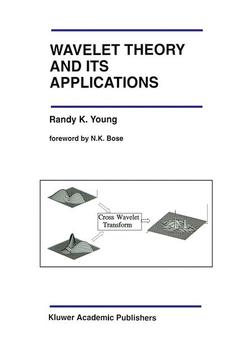Description
Wavelet Theory and Its Applications, 1993
The Springer International Series in Engineering and Computer Science Series, Vol. 189
Author: Young Randy K.
Language: English
Subjects for Wavelet Theory and Its Applications:
Approximative price 158.24 €
In Print (Delivery period: 15 days).
Add to cart
Publication date: 10-2012
223 p. · 15.5x23.5 cm · Paperback
223 p. · 15.5x23.5 cm · Paperback
Description
/li>Contents
/li>
The continuous wavelet transform has deep mathematical roots in the work of Alberto P. Calderon. His seminal paper on complex method of interpolation and intermediate spaces provided the main tool for describing function spaces and their approximation properties. The Calderon identities allow one to give integral representations of many natural operators by using simple pieces of such operators, which are more suited for analysis. These pieces, which are essentially spectral projections, can be chosen in clever ways and have proved to be of tremendous utility in various problems of numerical analysis, multidimensional signal processing, video data compression, and reconstruction of high resolution images and high quality speech. A proliferation of research papers and a couple of books, written in English (there is an earlier book written in French), have emerged on the subject. These books, so far, are written by specialists for specialists, with a heavy mathematical flavor, which is characteristic of the Calderon-Zygmund theory and related research of Duffin-Schaeffer, Daubechies, Grossman, Meyer, Morlet, Chui, and others. Randy Young's monograph is geared more towards practitioners and even non-specialists, who want and, probably, should be cognizant of the exciting proven as well as potential benefits which have either already emerged or are likely to emerge from wavelet theory.
Foreword.- Preface.- 1: Introduction/Background.- Wavelet Theory Basics - Scaling and Translation.- Appendix 1-A: Time Referencing.- 2: The Wavelet Transform.- Wavelet Transform Definitions and Operators.- Wavelet Transform Examples.- The Resolution of Identity.- Continuous Inverse Wavelet Transform Theorem.- Energy Distribution in the Wavelet Transform Domain.- Discrete Wavelet Transform (Continuous Time Wavelet Series).- Wideband Matched Filter Interpretation of the Lattice Density.- Review of the Inverse Discrete Wavelet Transform: Scale-translation Lattice Density and Mother WaveletConstraints.- Discrete Wavelet Mathematics - Rigorous Justification.- Discrete Time Wavelet Series.- Multiresolution, Orthogonal, and Biorthogonal WaveletTransforms (and PR-QMFs).- Discrete Time Wavelet Series - A Specific Structure.- Multiresolution.- Orthogonal and Biorthogonal Wavelet Transforms.- An Image Processing Example.- Appendix 2-A: Nonunique Wavelet Domain Representations.- 3: Practical Resolution, Gain, and Processing Structures.- Fourier/Narrowband Gain and Resolution Comparisons.- Multiple Mother Wavelets - Gain and Resolution PropertiesOnly.- Mother Wavelet Properties - Relationships to EstablishedTheories.- Signal Analysis - Time-frequency or time-scale Applications.- A Physical Interpretation of Scale-translation Resolution: Wideband Ambiguity Function Conditions.- Wideband Conditions.- Wideband Signals and the Analytic Signal Model.- Effective rms Time-bandwidth Product.- Wideband Systems and Signals.- Active and Passive Sensing.- Ambiguity Functions.- Reformulation of the WBCAF with Wavelet Transforms.- Properties of the Reformulated WBCAF.- Cross Wavelet Transforms and Signal Commonalities.- Appendix 3-A: Wideband/Narrowband Ambiguity Functions:Assumptions, Tradeoffsand Efficiencies.- Appendix 3-B: Narrowband Ambiguity Function Theory.- 4: Wavelet Theory Extensions and Ambiguity Functions.- Multiresolution/Orthogonal Wavelets versus UnconstrainedWavelets.- Sampling Grids.- Unconstrained Wavelet Transforms - Mother Wavelet Freedom.- The Mother Mapper Operator.- Unconstrained Wavelet Transforms/Mother Mapper OperatorProperties and Applications.- Mother Mapper Operator Applications.- Mother Mapper Operator - Final Considerations.- Further Research and Applications of the Mother Mapper Operator.- 5: Linear Systems Modelling with Wavelet Theory.- and Motivation.- Wideband/Nonstationary/Time-varying System Modelling.- The Wideband Signal Reflection Process.- Common Framework of System or Channel Characterizations.- The STV Wavelet Operator - Space-time-varying System Model.- STV Wavelet Operator’s Energy Distribution.- Estimation of the Wideband System Characterization.- Properties of the STV Wavelet Operator.- Examples of the STV Wavelet Operator.- Wideband Reflection: Comparing the LTI and STV Models.- Justification for the STV Operator Instead of Convolution forSignals Represented by Wavelet Transforms.- The STV Wavelet Operator in the Wavelet Transform Domain.- Space-time-varying System Identification Problem with Wideband/Nonstationary Input/Outputs.- Limitations of the STV Wavelet Operator - Time Referencing andNonlinear Time Variations.- Bi-wavelet System Representation: Time variation of the Time-varying System Model.- 6: Wideband Scattering and Environmental Imaging.- Scattering Theory.- General Scattering Function Background.- Narrowband Scattering Theory.- Wideband Correlation Receiver and its Output.- Wideband Point Scatterer Example.- Wideband Scattering Functions and Resolutions.- Physical Form of the WBCAF.- Time Delayand Scale Estimation.- WBAAF Moments and Assumptions.- Wideband Scattering Review.- Related Research.- References.
© 2024 LAVOISIER S.A.S.
These books may interest you

WaveletsA Student Guide 59.89 €



